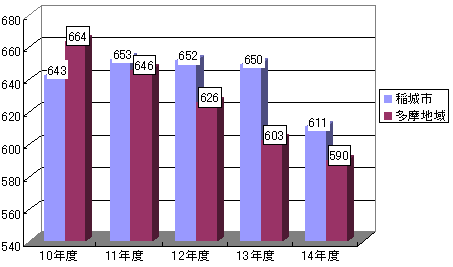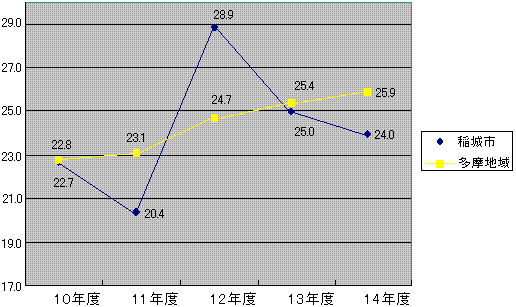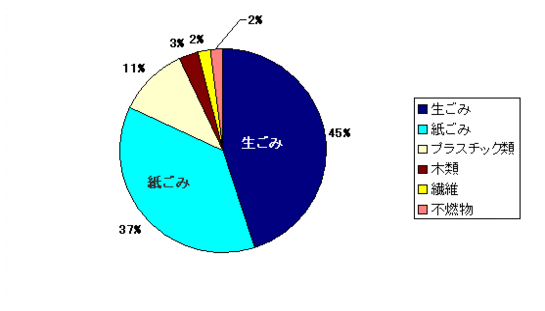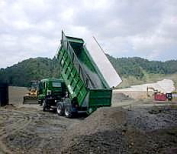Story until the introduction of paid household waste
When Inagi Town started garbage collection in April 1964, the service was charged.
Since April 1970, it became free of charge, but in October 1993, bulky waste collection was made chargeable, and in October 1994, business-related waste was also made chargeable.
Garbage disposal fees have changed over time along with the costs and concepts of fees. In Inagi City, household garbage over 10 kilograms per day is currently charged a fee, but with the recent revision of the garbage fee ordinance, a designated bag system has been introduced, and the fee has been revised to 10 yen per kilogram of garbage.
To help residents understand the current status of waste and the details of the revisions, we will provide information through the city website, public relations, and local briefing sessions.
Waste generation per person per day
Transition of (Burnable Garbage + Non-burnable Garbage)
Unit (grams)

Everyone's efforts have resulted in weight loss, but compared to the average in the Tama region, it is 21 grams higher in fiscal year 2002.
Transition of Recycling Rate
Recycling Rate = (Amount of resources recovered from resource collection + Amount collected from group collection + Amount of resources recovered after collection) ÷ (Total waste amount + Amount collected from group collection)

The resource recovery rate for the fiscal year 2002 is 24%. This is 1.9% lower than the average for the Tama region. We must further enhance waste separation and recycling efforts.
Analysis of Burnable Garbage Composition
Weight Ratio (Wet Basis) Survey from December 2002

45% of the weight of Burnable Garbage is kitchen waste, 37% is paper waste, and 11% is plastics. By simply squeezing out the moisture from kitchen waste, it can lead to a reduction of about 10%. Additionally, by sorting these materials and recycling them, waste reduction can be achieved. Paper larger than a business card should be classified as "zatsu paper" and sent for recycling of old paper, which is effective.
Trends in Municipal Waste Collection Processing Costs
|
Fiscal Year |
Collection |
Intermediate |
Final |
Expenses |
1 person |
1 Household |
1 |
|---|---|---|---|---|---|---|---|
| Heisei Fiscal Year 10 |
219,453,399 |
617,304,564 |
127,433,799 |
964,191,762 |
14,714 |
37,473 |
63 |
| Heisei Fiscal Year 2011 |
222,844,689 |
491,376,150 |
102,965,767 |
817,186,606 |
12,113 |
30,695 |
51 |
| Heisei Fiscal Year 2012 |
218,003,341 |
545,328,023 |
68,037,339 |
831,368,703 |
12,046 |
30,291 |
51 |
| Heisei Fiscal Year 2013 |
223,957,841 |
691,728,862 |
61,061,299 |
976,748,002 |
13,963 |
34,718 |
59 |
| Heisei Fiscal Year 2014 |
229,855,754 |
669,050,513 |
57,535,417 |
956,441,684 |
13,260 |
32,718 |
59 |
| 5 years Average |
222,823,005 |
602,957,622 |
83,406,724 |
909,187,351 |
13,211 |
33,142 |
56 |
In the fiscal year 2002, the total cost for the disposal of Burnable Garbage and Non-burnable Garbage, including collection and transportation costs, intermediate processing costs at the Tamagawa Sanitation Association, and final disposal costs at the San-Tama Wide Area Disposal Association, is approximately 956 million yen. This amounts to about 13,000 yen per person annually. Since the Municipal Tax is approximately 11.4 billion yen, about 8.4% of the Municipal Tax is allocated for the disposal of Burnable Garbage and Non-burnable Garbage.
Consideration of Waste Charging System
Progress
- September 1999
- Waste Reduction Promotion Council
Recommendation on "Revision of Fees for Business, Bulky, and Brought-in Garbage and Introduction of Paid Household Garbage" - January 2001
- Second Administrative Reform Outline
Proposal for Paid Garbage Collection Based on Fairness of Benefits and Burdens - March 2001
-
Complete Abolition of Dust Boxes
- March 2003
- Basic Environmental Plan Formulation (72 Measures)
- September 2003
- Waste Reduction Promotion Council
Submit Opinions on the Specific Details of Paid Implementation - December 2003
- City Council Ordinance Amendment Passed
Starting from October 1, 2004, a fee for garbage collection will be implemented.
Purpose and Effects of Charging for Household Waste
Extending the lifespan of the final disposal site
The incineration ash from Inagi City’s garbage is landfilled at the Futatsuzuka Disposal Site of the Santama Wide-Area Disposal Union located in Hinode Town.
However, as things stand, this disposal site is also expected to be full by 2013.
Promoting Waste Reduction and Recycling
In cities within the Tama area that have already implemented charging, an average of about 15% reduction in waste has been achieved.
Inagi City also plans to reduce waste by 15% through the introduction of fees.
Reduce waste disposal costs and ensure fair burden sharing
Currently, waste is generally processed through taxes, but with the introduction of fees, the burden will be equitably distributed according to the amount of waste.
Raise awareness of waste issues

Designated Bag Pricing
Respect for the recommendations and opinions of the Waste Reduction Promotion Council
(1) Volume-based collection using designated collection bags
Citizens bear about 20% of the waste collection and processing costs (Burnable Garbage and Non-burnable Garbage)
909,187,351 yen (5-year average collection and processing cost) ÷ 16,112 tons (expected emission volume) ÷ 1,000 kilograms per ton × 20% = 11.3 yen per kilogram
(2) Consideration for balance with neighboring municipalities
Average of 7 cities: 10 yen per kilogram
(7 cities = Ome City 8 yen, Hino City 14 yen, Kiyose City 7 yen, Akishima City 10 yen, Fussa City 10 yen, Higashimurayama City 12 yen, Hamura City 10 yen)
As a result, a fee of 10 yen per kilogram has been established.
PR for Everyone
We will take the following actions to inform everyone about the designated garbage bag (paid) system.
- Station and Street PR Practice
- Campaign by Waste Reduction Promotion Members and Staff
- Community Briefing Sessions for Neighborhood Associations
- PR for Small-Scale Collective Housing
- PR through Schools and Nursery Schools
- Inagi Newsletter - PR via the Inagi City Website
- PR using CATV
- Public Awareness through Banner Display
- Official Vehicle Panel Attachment
- PR and other activities at the Citizens' Festival and Living Festival
Please let us know your feedback on how to make our website better.
Inquiries about this page
Inagi City, Department of Urban Environment and Development, Living Environment Division
2111 Higashi-Naganuma, Inagi City, Tokyo 206-8601
Phone number: 042-378-2111 Fax number: 042-377-4781
Contact the Living Environment Division, Urban Environment Management Department, Inagi City



















